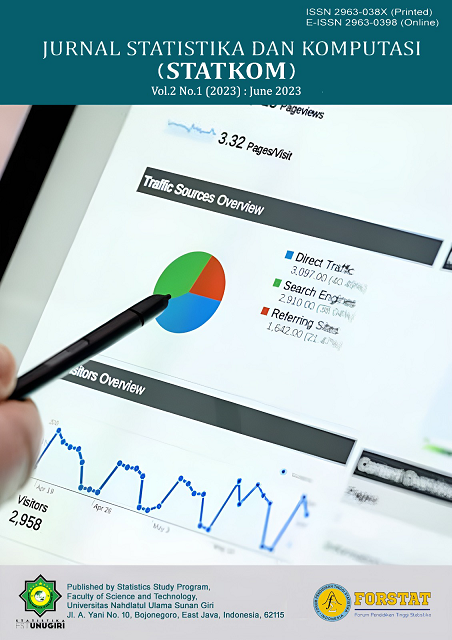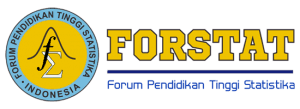Application of Double Seasonal Autoregressive Integrated Moving Average (DSARIMA) for Stock Forecasting
 PDF Download: 146
PDF Download: 146
DOI:
https://doi.org/10.32665/statkom.v2i1.1594Keywords:
Double SARIMA, Forecasting, MASE, MdAPE, StockAbstract
Background: Stock price forecasting assists investors to anticipate risks and opportunities in making prudent investments and maximizing returns.
Objective: This study aims to identify the most accurate model for stock forecasting.
Methods: This paper utilized the daily closing stock price of Unilever Indonesia, Tbk (UNVR) from January 1, 2018 to July 31, 202. Double Seasonal Autoregressive Integrated Moving Average (DSARIMA), was utilized in this study. Mean Absolute Scaled Error (MASE) and Median Absolute Percentage Error (MdAPE) are used to compare forecasting accuracy.
Results: Following conducting each model, we assessed that the best models are DSARIMAX (0,1,[4]) ([3],1,1)5(1,1,0)253, regarding MASE and MdAPE corresponding to approximately 1.423 and 0.111. The scope of this study has limitations to a test set for one-month forecast periods.
Conclusion: As stock prices rise, investors require precise forecasts. Models of forecasting must perform well. This analysis shows how the DSARIMA generate forecasts stock prices more accurately. This investigation evaluated the closing stock price of UNVR. Both MASE and MdAPE assess prediction. After analyzing each model, DSARIMAX (0,1,[4])([3],1,1)5(1,1,0)253 has the lowest MASE and MdAPE values, 1.423 and 0.111, respectively. The procedure lasted one month. Research may combine forecasts and improve their accuracy.
References
Bowerman, B. L., O’Connell, R.T.O., Koehler, A. B. (2005). “Forecasting, Time series, and Regression: an Applied Approach 4th ed”, USA: Brook/Cole, Thomson Learning, Inc.
Dinata, S.A.W., Azka, M., Faisal, M., Suhartono, Yendra, R. and Gamal, M. D. H. (2020). “Short-Term load forecasting double seasonal ARIMA methods: An evaluation based on Mahakam-East Kalimantan data”, AIP Conference Proceedings 2268, 020004, https://doi.org/10.1063/5.0017643.
Gupta, A., and Kumar, A. (2022). “Two-step daily reservoir inflow prediction using ARIMA-machine learning and ensemble models,” Journal of Hydro-environment Research, 45, 39-52, https://doi.org/10.1016/j.jher.2022.10.002.
Hayati, F. N. and Ulama, B. S. S. (2016) “Peramalan Harga Saham Jakarta Islamic Index Menggunakan Metode Vector Autoregressive,” Jurnal Sains dan Seni ITS, 2337-3520. http://dx.doi.org/10.12962/j23373520.v5i2.16931
Handani, S. and Astawinetu, E. D. (2020). Teori Portofolio dan Pasar Modal Indonesia, Scopindo Media Pustaka.
Hyndman, R.J. and Koehler, A.B. (2006) “Another look at measures of forecast accuracy”, International Journal of Forecasting, 22 (4), 679-688. https://doi.org/10.1016/j.ijforecast.2006.03.001
Khoiriyah, N., and Cahyani, N. (2022). “Peramalan Banyaknya Pasien Rawat Jalan dengan Menggunakan Metode Brown's Double Exponential Smoothing,” Jurnal Statistika Dan Komputasi , 1(1), 23-30, https://doi.org/10.32665/statkom.v1i1.451.
Li, Y., Wu, K., and Liu, J. (2023). “Self-paced ARIMA for robust time series prediction,” Knowledge-Based Systems, 269, 110489, https://doi.org/10.1016/j.knosys.2023.110489.
Mohamed, N., Ahmad, M. H., Ismail, Z. and Suhartono. (2010). “Double Seasonal ARIMA Model for Forecasting Load Demand,” MATEMATIKA: Malaysian Journal of Industrial and Applied Mathematics, 217-231. https://doi.org/10.11113/matematika.v26.n.565
Mado, I., Soeprijanto, A., and Suhartono, (2018). “Applying of Double Seasonal ARIMA Model for Electrical Power Demand Forecasting at PT. PLN Gresik Indonesia,” International Journal of Electrical and Computer Engineering (IJECE), 4892-4901. http://doi.org/10.11591/ijece.v8i6.pp4892-4901
Ning, Y., Kazemi, H., Tahmasebi, P. (2022). “A comparative machine learning study for time series oil production forecasting: ARIMA, LSTM, and Prophet,” Computers & Geosciences, 164, 105126, https://doi.org/10.1016/j.cageo.2022.105126.
Paningrum, D. (2022). Buku Referensi Investasi Pasar Modal, Kediri: Lembaga Chakra Brahmanda Lentera.
Perone, G. (2020). “An ARIMA Model to Forecast the Spread and the Final Size of COVID-2019 Epidemic in Italy,” HEDG - Health Econometrics and Data Group Working Paper Series, University of York. https://doi.org/10.48550/arXiv.2004.00382
Putri, R. N and Setiawan. (2015). “Peramalan Indeks Harga Saham Perusahaan Finansial LQ45 Menggunakan Metode Autoregressive Integrated Moving Average (ARIMA) dan Vector Autoregressive (VAR),” Jurnal Sains dan Seni ITS, vol. 4, (2015). http://dx.doi.org/10.12962/j23373520.v4i2.11162
Rahmadianto, B., Lesmana, D.C., Budiarti, R. (2022). Prediksi Harga Saham BBCA dan BMRI dengan Model Seasonal ARIMA”, Undergraduate Thesis, Actuarial, IPB University.
Rifai, N.A.K. (2019). “Pendekatan Regresi Nonparametrik dengan Fungsi Kernel untuk Indeks Harga Saham Gabungan,” Statistika, 19(1), 53-61. https://doi.org/10.29313/jstat.v19i1.4775
Silfiani, M., and Lembang, G.R. (2023). “Perbandingan Peramalan Jumlah Kasus Kecelakaan Lalu Lintas Kota Balikpapan dengan Linear Trend Analysis dan Double Exponential Smoothing,” EQUIVA JOURNAL 1 (1), 14-18. https://doi.org/10.35718/equiva.v1i1.757
Yamacli, D.S., Yamacli, S. (2023). “Estimation of the unemployment rate in Turkey: A comparison of the ARIMA and machine learning models including Covid-19 pandemic periods,” Heliyon, 9(1), https://doi.org/10.1016/j.heliyon.2023.e12796.
Downloads
Published
How to Cite
Issue
Section
License
Copyright (c) 2023 Jurnal Statistika dan Komputasi

This work is licensed under a Creative Commons Attribution-ShareAlike 4.0 International License.
Authors who publish in this Journal agree to the following terms:
- The author retains copyright and grants the Journal right of first publication with the work simultaneously licensed under a creative commons attribution license that allows others to share the work within an acknowledgement of the work’s authorship and initial publication of this Journal.
- Authors can enter into a separate, additional contractual arrangement for the non-exclusive distribution of the Journal’s published version of the work (e.g. acknowledgement of its initial publication in this Journal).
- Authors are permitted and encouraged to post their work online (e.g. in institutional repositories or on their websites) before and during the submission process, as it can lead to productive exchanges and earlier and more extraordinary citations of published works.
 PDF Download: 146
PDF Download: 146














